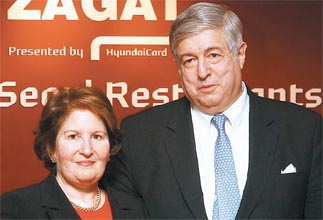Wisdom of Zagat’s dining masses finally reaches Seoul

Nina Zagat / Tim Zagat
Yes, the publisher of the restaurant criticism omnibus once known as “the Burgundy Bible” among New York foodies has finally arrived in Korea, releasing its first Seoul edition this week.
Tim and Nina Zagat, cofounders and CEOs of the company, visited Seoul this week, and said the firm hopes to roll out editions for other cities in Korea and elsewhere in Asia. “Zagat Seoul Restaurants 2010,” jointly published by Zagat Survey and its local partner Hyundai Card, rates 287 restaurants in Seoul in four categories - food, decor, service and cost - with brief descriptions by some 4,000 local diners. English-language versions of the reviews in the book will soon be made available on Zagat.com, according to Tim Zagat.

Tell us how you started Zagat. How did you differentiate yourself from other restaurant guidebooks like the Michelin Guide?
Tim: Nina and I started the survey as a hobby in 1979 by informally surveying a group of 200 friends on New York City restaurants. Back then, we covered only 100 restaurants. Today, over 31 years later, we have close to 400,000 active surveyors, and we cover restaurants, nightlife establishments, hotels, resorts, spas, cruise ships and airlines all around the world. And we make our content available on every platform we know to exist, including Zagat.com, Zagat-To-Go mobile devices, and we’re particularly proud that our application for the iPhone is the bestselling iPhone travel application among over 80,000 available.
Our belief today remains, as it was at the beginning of our business, that the shared opinions of thousands of avid consumers are inherently more accurate than the opinions of just one professional critic. Our biggest difference from the Michelin Guide is, first, we have 400,000 people eating all the time, including local people constantly eating in local restaurants nearby, unlike Michelin, which has five experts, often all from France, eating at very few places a few times ... I want to be clear that we like critics, but there are lots of analytical reasons having 4,000 people a year is more likely to be accurate than just one person.
Why did you decide to publish a survey on Seoul restaurants?
Tim: In addition to Korean cuisine, the dining scene in Seoul is very vibrant with global influences. The diversity of Seoul restaurants is evident looking at some of the top winners. For instance, Ristorante Eo, the winner of top food, is Italian, and the French restaurant in the Shilla Hotel, Continental, is the winner for service, while Ganga, the Indian restaurant, wins for popularity. Also, we have top-notch Korean restaurants like Bamboo House, Woolaeoak and Yongsusan on the list. And I think one of the most important things about these results is that they reflect what’s going on in the world as a whole.
In great cities, you find now a great diversity of cuisines. We cover over 90 cities around the world, and when we first started each city tended to be very local in terms of cuisine. But now, it’s really fascinating to see, now we see other types of cuisine coming in and being appreciated by locals. We’ve been living through restaurant revolutions that have been going on throughout the world in major cities, and I personally can tell you my life has been marked by seeing food start to change and the quality of food improve in city after city.
But the real reason we’re doing it in Seoul is that Hyundai Card first asked us to do this, and they made it easier for us to do the survey in Korea.
Any Seoul restaurants you found impressive, and any plans to publish more Zagat guidebooks for other Asian cities in the future?
Nina: Last night we went to Ristorante Eo, which got 26 out of 30 for food in our survey. We had a terrific dinner and we very much appreciated the information we got from the surveyors to lead us there.
Tim: We have Korean food in the U.S., which we always enjoy. There should be more Korean restaurants in my town because the food is like ambassadors or diplomats representing your country. I think the more Korean restaurants there are in major cities in the world, the more likely it is for tourism to increase in Korea.
We are currently covering six cities in Japan including Kobe, Osaka, Tokyo and Nagano; three cities in China like Beijing, Shanghai and Hong Kong, and Seoul in Korea. We want to expand very much in Asia. It’s obviously going through a great revolution, and it makes sense when there are so many good things to be surveyed with so many traveling now for us to cover more cities. In fact, when Hyundai Card told us we needed to cover more Korean cities I said yes in a minute.
By Jung Ha-won [hawon@joongang.co.kr]










with the Korea JoongAng Daily
To write comments, please log in to one of the accounts.
Standards Board Policy (0/250자)